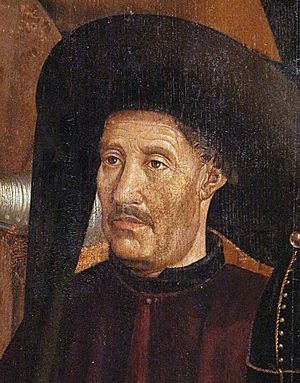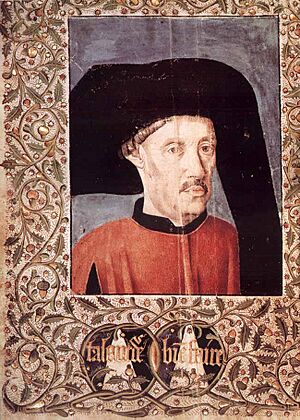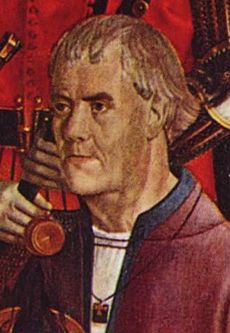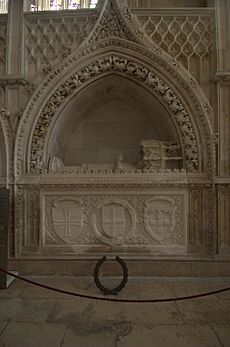Prince Henry the Navigator facts for kids
Quick facts for kids Prince Henry the Navigator |
|
|---|---|
| Duke of Viseu | |

Infante Dom Henrique; St. Vincent Panels
|
|
| Born | 4 March 1394 Porto, Portugal |
| Died | 13 November 1460 (aged 66) Sagres, Portugal |
| Burial | Batalha Monastery |
| House | Aviz |
| Father | John I of Portugal |
| Mother | Philippa of Lancaster |
| Religion | Roman Catholicism |
Dom Henrique of Portugal (born March 4, 1394 – died November 13, 1460) is better known as Prince Henry the Navigator. He was a very important person in the early days of the Portuguese Empire. He helped start the great European sea explorations in the 15th century. Many people see him as the main person who began the Age of Discovery. Henry was the fourth child of King John I of Portugal. King John I started the House of Aviz, which was the ruling family of Portugal.
Prince Henry helped develop a new type of ship called the caravel. This ship allowed Portugal to explore and trade by sea with other continents. He focused on exploring Western Africa and the Atlantic Ocean islands. He also looked for new sea routes. Henry encouraged his father to capture Ceuta in 1415. Ceuta was a port in North Africa. There, he learned about the rich trade routes across the Sahara Desert. He became very interested in Africa. He also wanted to find the legendary Christian kingdom of Prester John. Prince Henry is often called the patron, or supporter, of Portuguese exploration.
Contents
Prince Henry's Early Life
Henry was the third son of King John I and Queen Philippa. His mother was the sister of King Henry IV of England. Henry was likely born in Porto, Portugal. This was probably when his parents were living in the city's old mint building. Today, that building is called Casa do Infante, or the Prince's House.
When Henry was 21, he and his father and brothers captured the port of Ceuta in northern Morocco. This happened in 1415. Ceuta had been a base for Barbary pirates. These pirates often attacked the Portuguese coast. They would capture people to sell them into slavery. After this victory, Henry started to explore the coast of Africa. Most of this coast was unknown to Europeans at the time.
Henry had several goals for these explorations. He wanted to find the source of West African gold. He also hoped to find the legendary Christian kingdom of Prester John. And he wanted to stop the pirate attacks on Portugal's coast.
At that time, the ships used in the Mediterranean Sea were too slow and heavy. They could not make long ocean voyages. So, under Henry's guidance, a new, lighter ship was created. This ship was called the caravel. It could sail farther and faster. Most importantly, it was easy to steer. It could also sail "into the wind" using its lateen sails. This meant it did not depend as much on the direction of the wind. With the caravel, Portuguese sailors could explore unknown waters. They could travel from rivers to the open ocean.
In 1419, Henry's father made him the governor of the Algarve region.
How Prince Henry Funded His Journeys
On May 25, 1420, Henry became the Grand Master of the Military Order of Christ. This was a powerful religious and military group in Portugal. It was the successor to the Knights Templar. The Order's main base was in Tomar, central Portugal. Henry held this important position for the rest of his life. The Order provided a lot of money for Henry's big plans. This was especially true for his efforts to take over the Canary Islands. Portugal believed it had discovered these islands before 1346.
In 1425, Henry's second brother, Peter, Duke of Coimbra, traveled around Europe. Henry asked him to look for new maps and geographic information. Peter returned with a current world map from Venice.
In 1431, Henry gave buildings for the Estudo Geral. This was a place to teach many subjects. These included grammar, logic, math, music, and astronomy. This place later became the University of Lisbon.
Henry also had other ways to get money. When King John I died in 1433, Henry's oldest brother, Edward of Portugal, became king. King Edward gave Henry all the profits from trade in the areas he discovered. He also gave Henry the only right to approve expeditions beyond Cape Bojador. Henry also had a special right to fish for tuna in the Algarve. When Edward died eight years later, Henry supported his brother Peter, Duke of Coimbra. Peter became the regent, ruling while Edward's son, Afonso V, was too young. In return, Henry's trading rights were confirmed.
Henry helped plan a difficult trip to Tangier in 1437. This trip did not go well. Henry's younger brother, Ferdinand, was taken hostage. He was held to make sure Portugal kept its promises in a peace deal. The Portuguese parliament refused to give back Ceuta to free Ferdinand. So, Ferdinand stayed captive until he died six years later. Prince Regent Peter supported Portugal's sea exploration. Henry also helped settle the Azores islands during Peter's time as regent (1439–1448). For most of his later life, Henry focused on sea activities and royal politics.
Sagres and Exploration
It is often said that Prince Henry gathered a school of navigators and map-makers at his villa in Sagres. This idea is very popular. However, modern historians now believe this is not true. Henry did hire some map-makers to chart the coast of Mauritania. This was after he sent ships there. But there was no formal school for navigation science. There was also no observatory or organized center for navigation.
A Portuguese mathematician named Pedro Nunes wrote about Sagres in the 1500s. He said, "from it our sailors went out well taught and provided with instruments and rules." This shows that sailors learned important skills there.
The idea that Henry's court quickly became a high-tech base for exploration is a myth. It is repeated in popular culture but has never been proven. Henry was very curious about geography. He did hire cartographers, or map-makers. Jehuda Cresques, a famous cartographer, was said to have come to Portugal to make maps for the prince. Some historians believe that Cresques's presence likely started the legend of the "School of Sagres."
The first times Portuguese ships met the African slave market were to free Portuguese people. These people had been captured by pirates attacking Portuguese ships or villages.
Prince Henry's Explorations
Henry helped pay for many sea voyages. He collected a 20% tax on any profits. This was a common practice in Portugal and Spain at the time. The nearby port of Lagos was a good home base for these trips. The voyages used very small ships, mostly the caravel. These were light and easy to steer. They had lateen sails. Most of Henry's voyages used one or two ships. They sailed by following the coast. At night, they would stop and tie up along the shore.
During Henry's time, Portuguese sailors learned a very important trick. It was called the volta do mar, or 'turn of the sea'. This was a reliable pattern of winds in the North Atlantic. Near the equator, trade winds blow mostly from the east. In the mid-Atlantic, westerlies blow back towards Europe. Understanding these wind patterns was key for Atlantic navigation. It allowed ships to travel from Africa and the open ocean to Europe. This route was later used by Christopher Columbus on his trips across the Atlantic. Even though lateen sails allowed sailing against the wind a bit, it was better to go out of the way to catch a faster following wind.
Discovering Madeira
The first explorations happened soon after Ceuta was captured in 1415. Henry wanted to find where the gold caravans came from. During his father's rule, João Gonçalves Zarco and Tristão Vaz Teixeira were sent to explore the African coast. Zarco was a knight who served Prince Henry. He had commanded ships that protected the Algarve coast from Moors. He had also been at Ceuta.
In 1418, a storm blew Zarco and Teixeira off course. They were trying to use the volta do mar to return to Portugal. They found shelter on an island they named Porto Santo. Henry ordered that Porto Santo be settled. Portugal probably claimed the Madeira islands to stop Spain from claiming the Canary Islands. In 1420, settlers moved to the nearby island of Madeira.
Exploring the Azores
A map made by the Catalan map-maker Gabriel de Vallseca suggests the Azores were first found by Diogo de Silves in 1427. In 1431, Gonçalo Velho was sent to find the "islands" that de Silves had seen. Velho probably reached the Formigas rocks in the eastern Azores. He then had to return to Sagres, likely because of bad weather.
By this time, Portuguese sailors had also reached the Sargasso Sea. This is a part of the western North Atlantic. They named it after the Sargassum seaweed that grows there. Sargaço is the Portuguese word for this seaweed.
West African Coast Exploration
Before Henry's time, Cape Bojador was the southernmost point Europeans knew on the African desert coast. Sailors believed sea monsters and the edge of the world lay beyond the cape. In 1434, Gil Eanes, who led one of Henry's trips, became the first European known to pass Cape Bojador.

Using the new caravel ships, the expeditions pushed forward. Nuno Tristão and Antão Gonçalves reached Cape Blanco in 1441. The Portuguese saw the Bay of Arguin in 1443. They built an important fort for trading slaves on the island of Arguin around 1448. Dinis Dias soon found the Senegal River and sailed around the Cap-Vert peninsula in 1444. By this point, the explorers had passed the desert's southern edge.
From then on, Henry's wish came true. The Portuguese had found a way around the Muslim land trade routes across the western Sahara Desert. Slaves and gold began to arrive in Portugal by sea. This new sea route hurt the trade in Algiers and Tunis. But it made Portugal rich. By 1452, so much gold was coming in that Portugal made its first gold coins, called cruzados. A cruzado was worth 400 reis at that time. From 1444 to 1446, about forty ships sailed from Lagos for Henry. The first private trading trips also began.
Alvise Cadamosto explored the Atlantic coast of Africa. He discovered several islands of the Cape Verde archipelago between 1455 and 1456. On his first trip in 1455, he visited the Madeira and Canary Islands. On his second trip in 1456, Cadamosto was the first European to reach the Cape Verde Islands. António Noli later claimed credit for this discovery. By 1462, the Portuguese had explored the coast of Africa as far as present-day Sierra Leone. Twenty-eight years later, Bartolomeu Dias proved that Africa could be sailed around. He reached the southern tip of the continent, now called the Cape of Good Hope. In 1498, Vasco da Gama became the first European sailor to reach India by sea.
No one called Prince Henry "Henry the Navigator" during his lifetime. This nickname was not used for the next three centuries either. Two German historians in the 1800s first used the term. Later, two British authors made it popular. They used it in the titles of their books about the prince. These authors were Henry Major in 1868 and Raymond Beazley in 1895. In Portugal, even today, people usually call him "Infante D. Henrique."
Unlike his brothers, Prince Henry was not praised for being very smart by people who lived at the same time as him. Only later writers, like João de Barros, said he was a scholar. They also said he was interested in the study of the universe. The idea of the "Sagres school" that Prince Henry supposedly started was created in the 1600s. It was mainly spread by Samuel Purchas and Antoine Prévost. In 19th-century Portugal, the idea of Prince Henry as a great pioneer of exploration and science became very strong.
A book published in 1824, Travels in Brazil, mentioned that "the Infant Don Henrique Navegador" brought sugar cane to Brazil.
See also
 In Spanish: Enrique el Navegante para niños
In Spanish: Enrique el Navegante para niños




